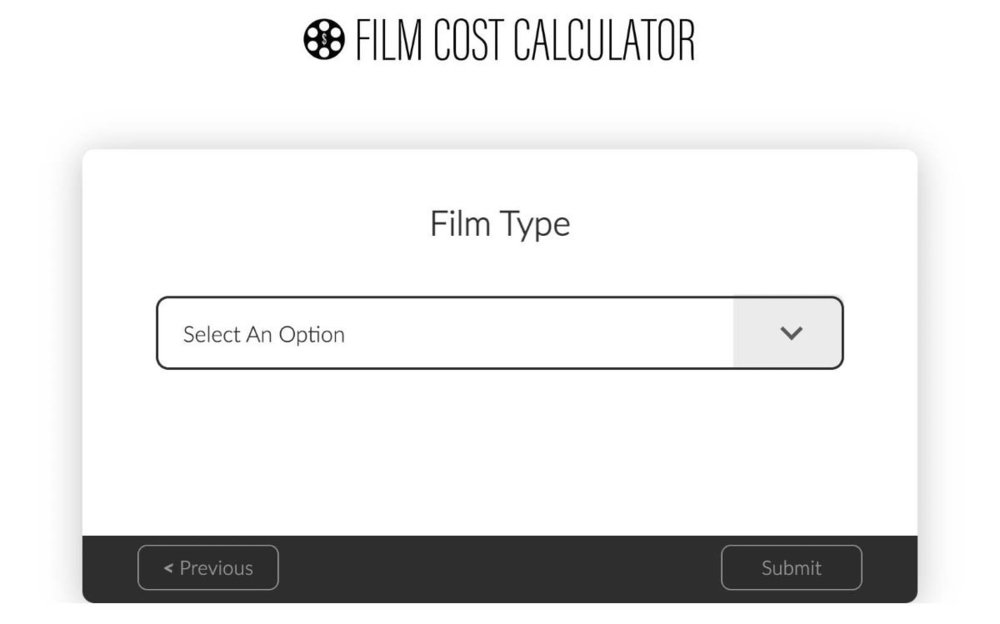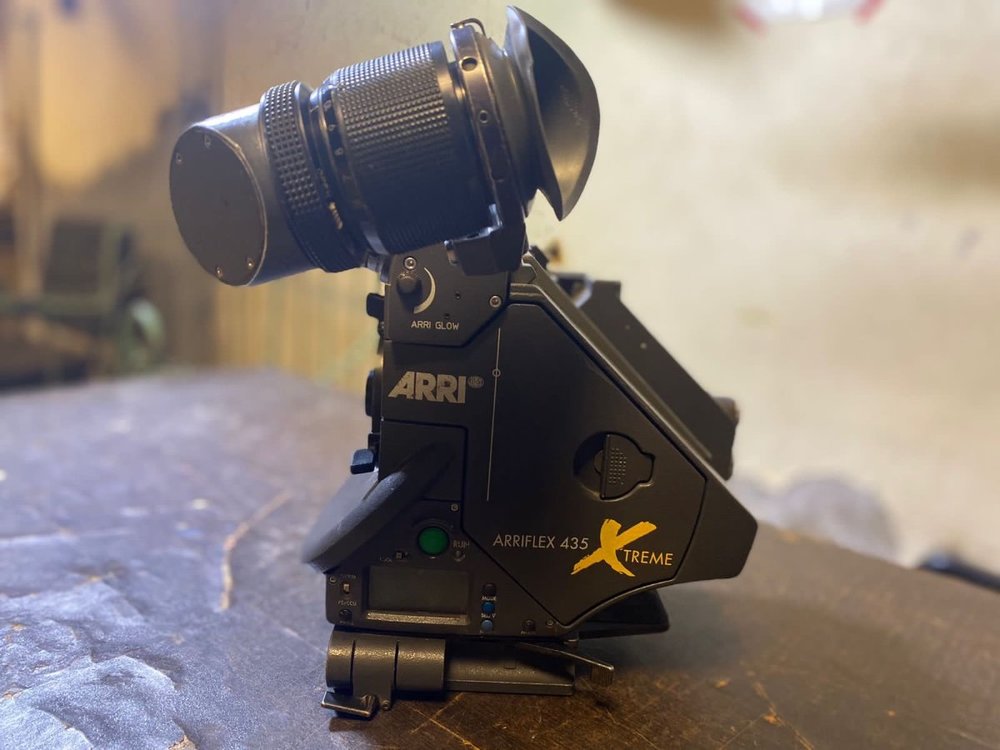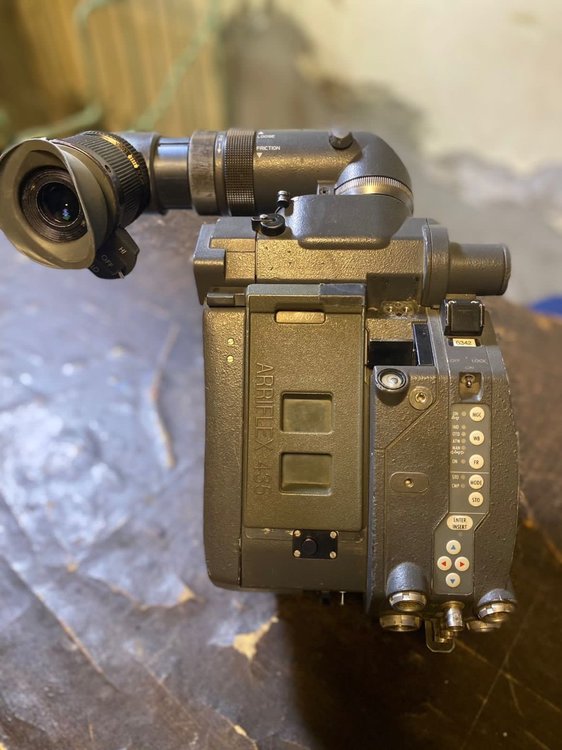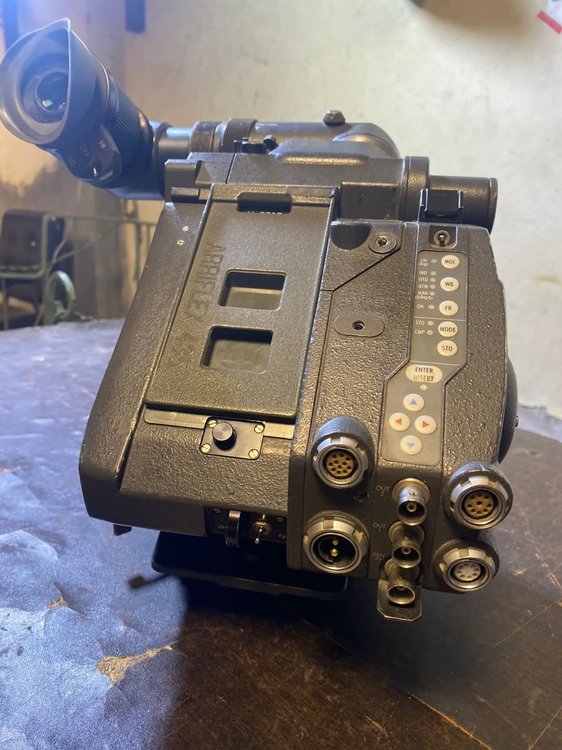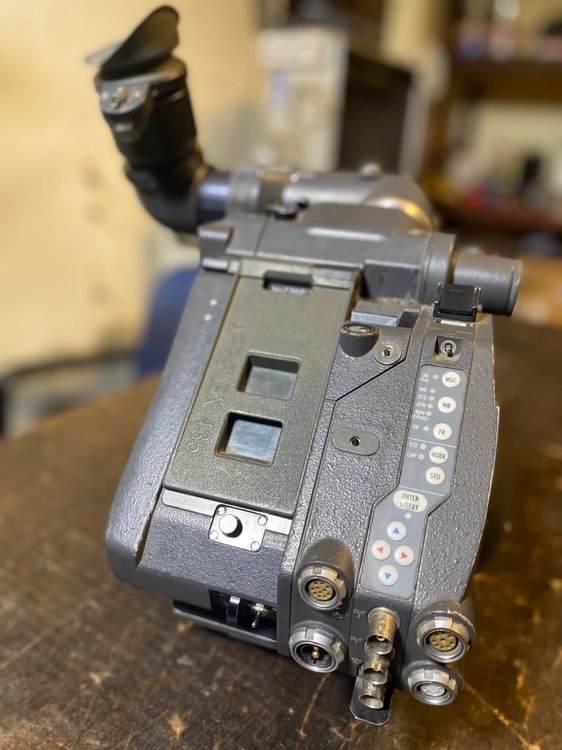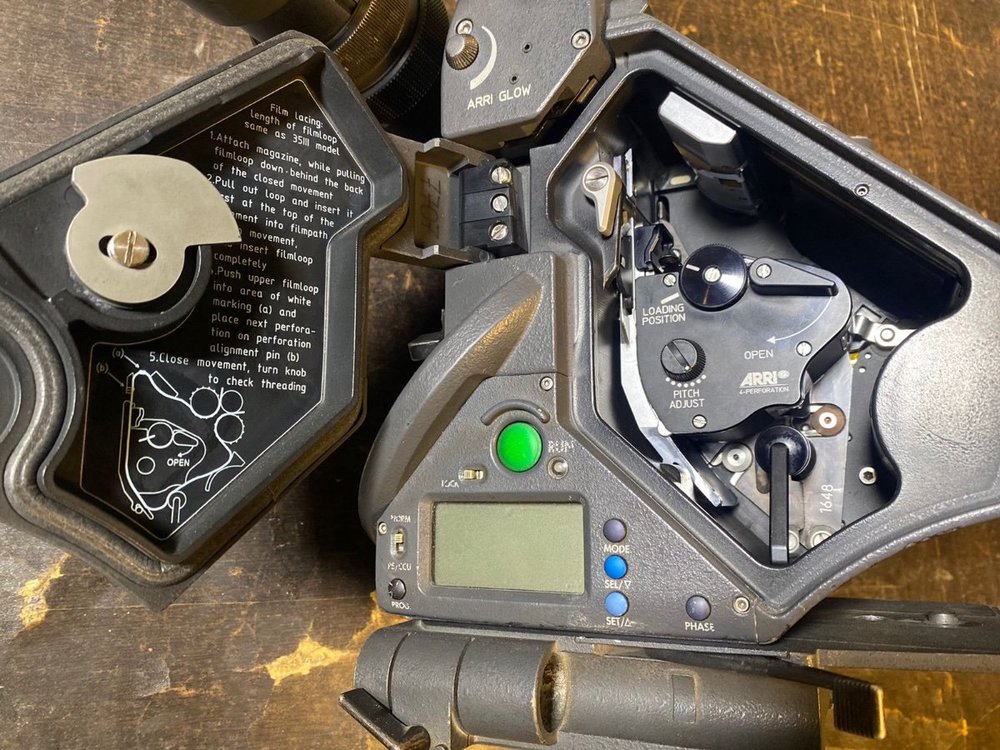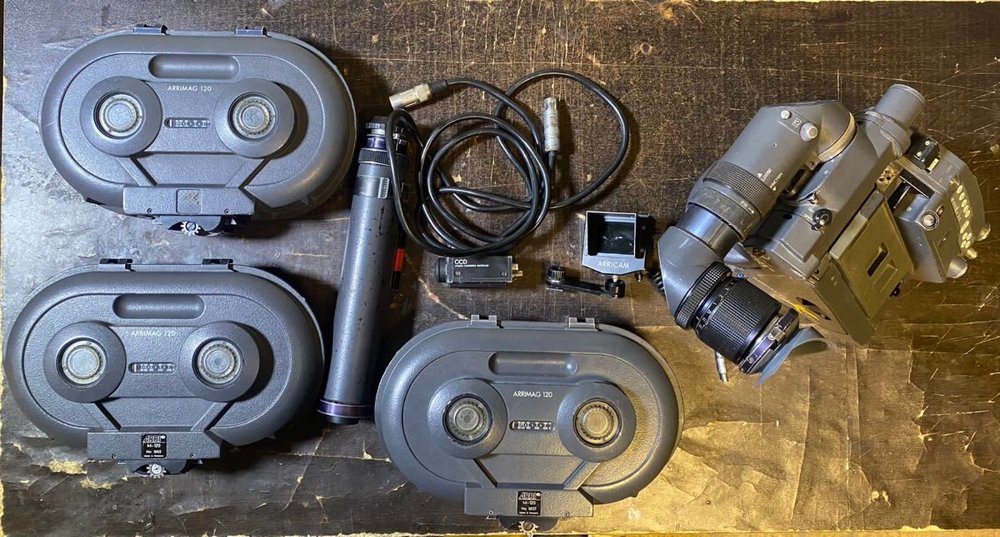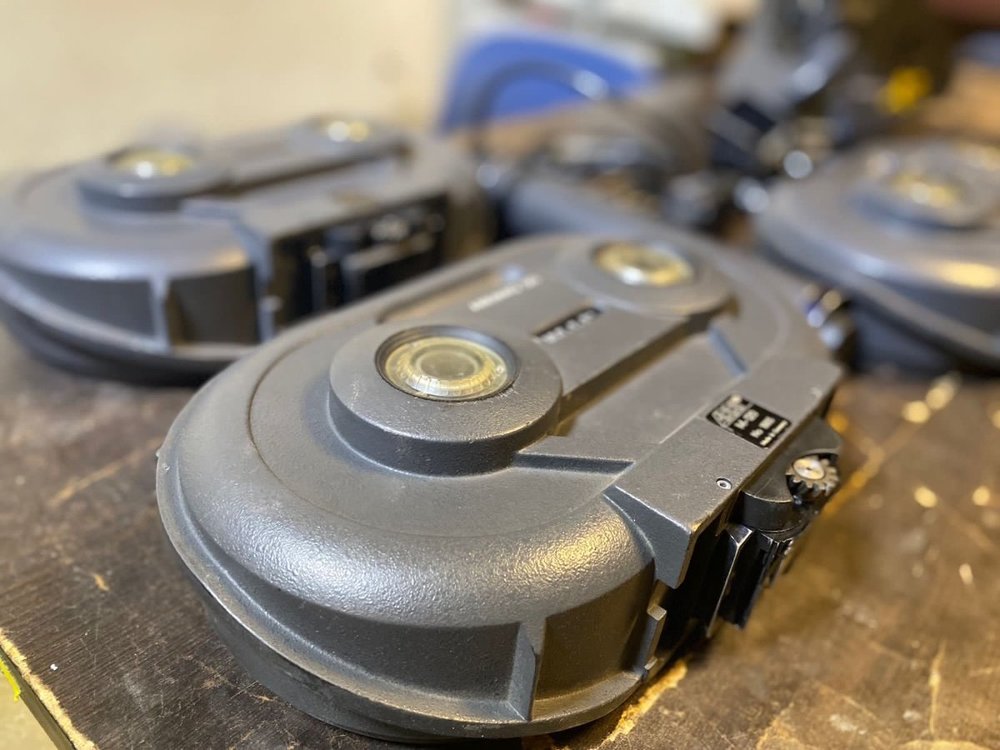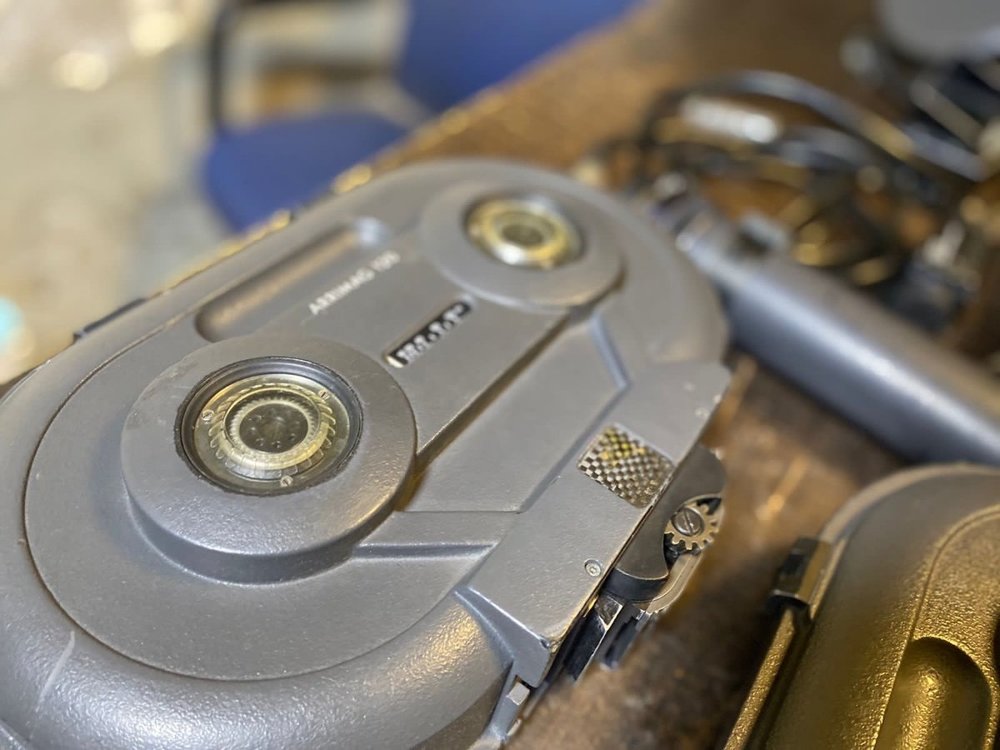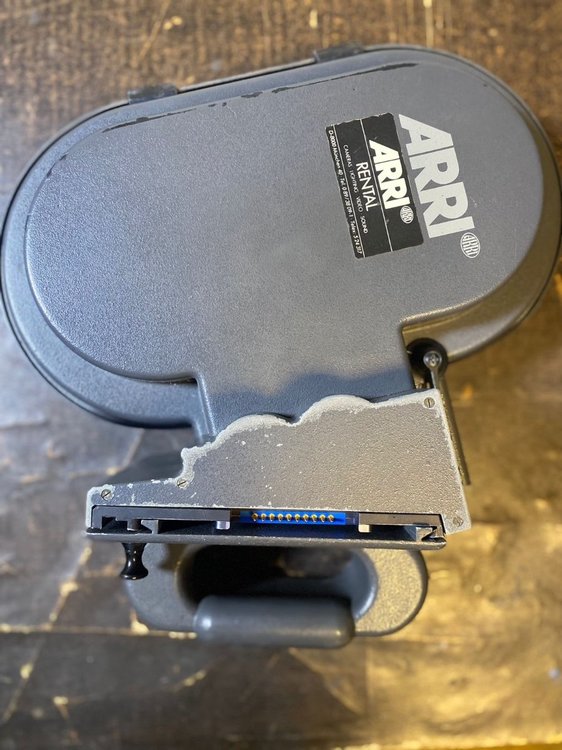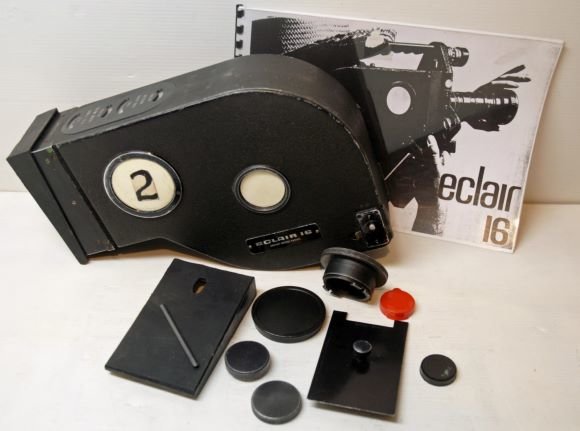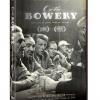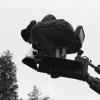Search the Community
Showing results for tags 'film'.
-
Hi everyone, I just have a few questions about storing, shooting film and then sending it of film to the lab. I have fresh Vision 3 stock that I am keeping in a freezer. I am shooting in South-East Asia and here its always hot and humid so when I take a can out of the freezer to acclimate the stock it straight away condensates because of the heat 20-30 degreese celsius. Should I bring it from the Freezer to a Fridge and later bring it out of the Fridge into room temperature or it doesn't matter? If I dont open a can do I after put it in a fridge or a freezer for the next day or week? After having shot something should I put the short ends back into the fridge or freezer? I guess the exposed negs until I send them to the lab they should go back to the fridge, right? Thanks!
-
Hi, is anyone willing to share their knowledge on using the Arricam system of cameras? I’ll be shooting with the Arricam LT and I don’t have any experience with it (or film cameras, in general). Regarding battery solutions, the Anton Bauer Cine VCLX batteries seem to be the closest thing to the de facto standard battery for this 24V camera. And while I’m open to using a block battery, I’m curious if there are any other preferred battery solutions, especially concerning hand-held use. While I’ve heard of battery belts, I’ve never used one myself and I don’t know how comfortable I am strapping large batteries around my waist. Maybe it is a good solution though, considering the alternatives. How much wattage does the camera consume while filming at different speeds? It’s been difficult to find this information. The manual states the Power Bridgeplate is the standard plate used with this system. Will other ARRI plates, such as the BP-8 bridge plate, fit as well? The standard video assist system (IVS) operates on the aged NTSC/PAL system (and I have little hope of getting my hands on the HD-IVS). It seems the best signal output is S-Video. This isn’t an ideal connection for production use, but can anyone recommend a monitor that has an S-Video input? Or, should I just stick with the BNC Composite signal? Or, is it worth it to use a convertor box to covert the signal to SDI? Any modern-day, practical advice regarding these cameras would be very helpful. Thanks!
-
Hello, so to me, 35mm motion picture film just doesn’t have an aesthetic quality over modern digital cameras as I struggle to tell the difference half the time, unlike with say super 16 which I find does register with me as being filmic, even with grain removed. Like, I have to tell myself as I watch a modern 35mm film that it was shot on film, some examples for me are don’t look up and the northman, and even with films that attempt to emulate older time periods like licorice pizza and once upon a time in Hollywood, I just don’t see the image find it looking like eras they’re emulating, they look modern to me, which is not to say they’re bad, they look great, I just struggle to feel those films as being shot on film despite the fact they were. and whatever textural quality there is to 35mm film, I find is easy to replicate with film emulation, and I even heard of some 35mm productions like hbos winning time using film emulation as the film was too clean on its own so they added grain that would look more like 16mm film and at that point I ask, why not shoot it on 16? But then again, maybe I'm wrong and there is an inherent quality to 35mm film, let me know your thoughts.
-
hey all. wanted to share this film cost calculator that I've been working on for a while. www.filmcostcalculator.com Eventually I'd like to add more equations that can list out alternative results to compare various perf options. Also working on a 1000' roll calculator. Hope it helps! Feel free to comment with any notes and ideas.
-
Hi, I'm a student cinematographer with a shoot coming up, on 16mm with the Arri SR3. I have a couple of shoots planned during the blue phase of magic hour (civil twilight and the blue hour), on a beach. I think I'm correct in saying that I need to shoot with daylight colour balance to match the blue tones in the sky as tungsten will make them even cooler? I was wondering if anyone has any thoughts on the different aesthetics of 500T and 250D? (aside from the obvious sensitivity and colour balance differences). Is there any particular advantage (visual or otherwise) to shooting 500t with an 85 or 250d straight up? All the best, Connor
-
I know there are many Krasnogorsk haters on this forum but I wanted to share this awesome project by Russian DP Max Ivanov. It's been 2 years in the works and so much effort has been put into this with a ton of custom machined parts and boards. Here are the specs as shared on the Instagram page for the project: - Camera works with 7-12V batteries (it has a 2-pin lemo connector for power input) - Swiss 100 watt BLDC Motor. (BLDC motors have longer service life and were installed on the Aaton A Minima, XTR Prod, Arri 416.) - Motor controlled and stabilized by a microcontroller - Sync is accurate to 0.001fps at 25fps. (between 0.01-0.001 at other framerates) - Framerates: 1-50 fps - Video tap is based on GoPro internals which allows to record the tap feed in-camera. (Max said he will be adding a cable clamp / adapter since it uses the unreliable micro-hdmi connection from the gopro internals) - Optical viewfinder can be used at the same time as the video tap - Wi-Fi control which allows to set framerate and run/stop wirelessly via your phone - Electronic footage counter. (Maintains footage count after being powered off and has a reset button) - Super 16 gate with ground glass adjustment mechanism. FFD can now be easily tuned and will be precisely set on every model. Max will also be selling a set of tools for calibrating the FFD on this camera so you will be able to calibrate it yourself (I can already hear some of you complaining about how nobody should attempt to do this on their own unless they're a trained technician) - Super 16 viewfinder with correct markings - PL Mount Obviously not a camera for every situation, like narrative projects or basically anything with dialogue. However, I think it's perfect for more abstract projects like music videos or fashion films, especially when you need to move fast and do dynamic handheld stuff. I have one preordered and am super excited to test it out once it's ready! (I think the current eta is March/April)
- 29 replies
-
- krasnogorsk
- krasnogorsk3
- (and 14 more)
-
-
Hey all I recently purchased an analog to sdi mini converter from blackmagic design for my Aaton XTR Prod. Tried it out the other day and I'm having trouble getting a signal to my monitor. Any ideas or possible solutions? Thanks!
- 1 reply
-
- Blackmagic
- film
-
(and 6 more)
Tagged with:
-
Hi my name is Boris and I’m a director in Rhode Island. I’m new to the area and unfamiliar with camera rental houses in area. I’m in dire need of Arri Sr3 or Arri416 for short film. I’m looking to rent for 2 days. Please let me know if anyone or any place has it available near my area
-
Hi, might be a silly question, but is it possible to buy a brand new film camera? like arri sr3 or arricam. Do they even make new ones? Another question. Do you know any reliable store\dealer who sells arri film cameras (sr3 or arricam)? Preferably in Europe. Thank you.
-
Up for sale is the Eclair NPR Super 16mm camera package in great condition. Package comes with these: - Camera converted to Super 16, with a PL Mount & "C" Mount; ground glass re-centered for S16. - Lens converted from its "CA" Mount to PL Mount. - New battery, cable and charger, tested to be fully functional. Items also included: - Angenieux 9.5 / 95mm... 1:2.2 lens PL Mount + sun visor and directional rod. - Protective cover and soundproofing / blimp... for camera. - 2 120meters magazines. - Perfectone motor. - 1 Flight case. - Facsimile of the original instructions for use. The Price is 2060 GBP (the cost of shipping not included) Items location is Wales. Camera and lens conversion fully done by Les Bosher; battery, cable and charger with modern components also replaced and tested by him. Communication with him about any concern is encouraged. Camera recently serviced, and operation checked by the same camera engineer, it's all ready to shoot. No issues. Images below shows the items that come with the package. Attached Images: (Photos are of camera before upgrading)
-
REAL FILM at film festivals... Kind of makes sense, right? Well, not on the modern "film" festival circuit. Every film festival I have attended or been a part of the last five years (live or online) is primarily about HD. Usually I am the only filmmaker who shoots on film when my films play at a festival, unless the festival is truly specific to ACTUAL FILM, like the United States Super 8 Film and Digital Video Festival. You see how the title of the festival states FILM and digital video...? Recently I attended the 2022 Spring Austin Micro Film Festival. A really cool Festival! I had two experimental films play, WAITING FOR LEGROS and WAITING FOR LEGROS 2: THE EYE OF THE TIGER Both films shot on Super 8. I was surprised to see another film the was shot on film at the festival, and it was really good! I am pleased to announce that my latest short film THE UNMENTIONABLES (16mm, Tri-X 7266) will play at the 2022 Oregon Short Film Festival. I hope to see more films shot on film in the future! Don't give up on it!
-
Hey all. Happy holidays and happy new year. 2020 is now hindsight (thank god). First off, I have a lot of reverence for what you guys do. Many of you on this forum I'm a huge fan of, so it's an honor even in a small way to be writing this. So thanks for listening. Overwhelmed by choice overload. I tend to be a little too good at matching pros with cons and vice versa, so this amount of indecision (and the self-awareness about the indecision) has been difficult. Hence the need to reach out. I'll cut to the chase since I don't want to waste anybody's time. I'm looking to own a camera, thats what this is about. I've got enough $ to own a Komodo production kit with tax. I'll outline choices at the end. The purpose is for me to just feel empowered to get out and make films and work as a director / operator full time versus a owner / op who just rents his camera out to DP's other peoples stuff primarily. I do that for money occasionally the same way I color or edit or crew for people occasionally but my full step forward is towards going from one project to the next on my portfolio. Until then, here's a lot of ridiculous background and way too much information. I'm a filmmaker who prefers self-operating, but mainly for the intimacy and connection with the actors and for how it helps me concentrate, not because I consider myself a proper image-maker at heart, like I'm sure some of you do. My passion is mainly storytelling, not gear, though I'm well capable of digging into deep rabbit holes of technical details if it means getting exactly what I want when I want it. Background: age 25, Burbank-native, editor primarily (that's certainly where most of my superficial skills lie) I'm experienced in that I've made shorts since I was 10 years old. My first feature did get distributed by Gravitas and won a lot of awards - so I'm not totally untalented. But it was exhausting getting there. And in general, I hate the word "content" and have no intention of being a "content creator" at all, ever. Just want to keep telling stories in the way that feels truest to my heart, and make the strongest step forward. Life doesn't make a lot of sense when I'm not making films. And I need to make films right now. What's been hard is not having anything to express myself with. Like many of you, I'm relegated to primarily being at home, needing to channel energy. I've got stuff to shoot, I'm always writing and working with friends on writing films. I told myself I will just rent, that the entirety of hollywood infrastructure is built upon the idea that you don't own your own gear - that its better to just own lenses, which I still do. Logically, I still believe that. Emotionally though, whats been hard is not having that tool to express myself with. I know that theres an argument to be made for todays infrastructure being different from shooting 10 years ago, that being an owner operator now especially as a young person is fairly valuable. I also know its the story, performances, composition, movement, and lighting (in that order) that makes it, not the gear. Furthermore, Steve Yedlin's right. Camera's today are really just data collection tools. Even film cameras are glorified boxes the film goes through. I like being a colorist and relish the freedom it gives me. But its almost a separate part of my brain. The part of me on set thats connected to the actors and the story, that's the part I wanna grow. But still for me, film nearly always looks better. I have been fooled a few times, but only when they shot on anamorphic lenses. Linus Sandgren isn't wrong about the distortion of those being almost necessary in a twisted sort of way. His work, plus Maniac, 10 Cloverfield Lane, and a few others I find truly exceptional. If I'm to collect data, then the data I actually care about (which makes film superior) is the motion cadence of a global shutter, the ability to sandblast highlights and still have it look cool, and the ability to oversaturate or shoot in harshly oversaturated environments. That's the data set I'm looking for in a camera to own. Recently wrapped up a short on the Red Komodo which I made for an AFI application. Super happy with the image and versatility of R3D, which is inspiring in how it almost dares you to challenge it and push it to its limits. I love that you can beat the tar out of it in post and it never bands or splotches or falls apart. We even did a filmout from the R3D files to a 16mm sized portion of the negative at Fotokem, just to see how close Komodo could get to film, since its the first camera with films dynamic range and a global shutter. Astonished by the results - so much so I genuinely think I could film out everything I've ever done and get the best of both worlds (Most of my heroes are people who utilize the best of both, or create an invisible third option by kicking down the door) Still, something about shooting digital with that camera did not feel right to me. Could have been the stress of mounting COVID productions in general being a huge hassle, but also (while I appreciate lightweight cameras) I've never been a fan of feeling like I'm holding a DSLR. (Though BOY is it nice when you wanna shoot illegally. Had the Canon C70 existed before, my feature would have been completed considerably faster.) Tested the Varicam LT for the short first because that's been my favorite look on digital (perfect mixture of RED's cutting edge and Arri's painterly qualities) but weirdly, wasn't as good as Komodo, was heavy, and was bothered by the rolling shutter on that as well. Which was disappointing, because shooting 3200 iso in camera and NDing for exposure compensation is the closest I've seen to film grain yet. Plus Varicam colors are more Eterna than Vision3, and I'm definitely more of an Eterna guy. I've used lots of cameras, but owned only 2. HVX200 was the camera I learned on and in some ways it spoiled me. Got used to global shutter and undercranking & overcranking and timelapse photography and thick viewfinders and shooting to tape and it's been hard finding cameras that feel that level of satisfying. Owned a c100, but was never happy with it. Most of shooting my feature was about pushing that thing to its absolute limit in every conceivable way (to the point it stopped turning on altogether). After that, I owned the S1H for a bit, mainly because of my history with the HVX200 & how much I liked the Varicam. Sold it. Got WAY too into the whole idea of kitting it out to oblivion, trying to turn it into something its not - and became unhappy. Image was lovely but HATED the rolling shutter. Any readout 15ms or greater seems similar to the Haas effect in acoustics, where you don't truly perceive it until its in the 15ms to 30ms range. Though our eyes are way sharper (hehe) than our ears, so its probably more like 7ms or greater (at least for me). I've used lots of cameras, owned only a few. Mainly, the c100 Mark I, and the S1H for about 6 months. Unhappy with both. As badly as I want to like the EVA1, the image is beautiful, its the only camera I've ever used which actually enrages me ergonomically. That horrible plastic body and screen and clickless dial which makes menus impossible to navigate. Blackmagic is a fascinating player in the scene, and has the best menu system ever but I hate how every college kid or person my age uses them. I know you can color them to look however you want but I hate having to give myself so much to do, and I hate their lack of quality control. My choices so far have boiled down to these 3. I'm discounting options which I believe will be useless in 10 years. Komodo seems of all the new cameras to be the one best primed for the test of time, and the Alexas proven her stripes, and film, well, film is film. I want this to be (if at all possible) the last time I purchase a camera, at least for a decade. I also hate how every manufacturer uses the word FUTUREPROOF. 1. Red Komodo. Have the experience with it, love the image, and of course - the global shutter innovation makes it (to me) the most exciting digital camera in the world at any price level. I know people do get hired because of the Red bias, too, which is nice. Unless I get super creative though, it's gonna be forever till they actually get in stock. But: I can afford to get a decent run and gun kit, and after the initial charges, I'd never have to pay again to create, and I'd have the closest approximation to film motion cadence on a digital sensor. With that ND wheel from Kippertie it'll be great. Genuinely, I do feel its the ultimate tool for someone my age in the year 2020, if properly utilized (and yes, utilized in a way that's different from REDs design purpose). To me, it seems like Reds Mini. The Alexa Mini was a drone camera that became an A cam, too. I don't like having to lean down and look at that tiny screen, but part of me also feels this may help my compositions, and force concentration on framing better. I know I do function better with some limitations. All in all, I love the Komodo in spirit, mainly because it appeals to the more "fly by the seat of my pants" part of me, the one that believes in taking risks and stuff. The young punk, lol. 2. Alexa Classic. I don't need the resolution (2K's my favorite) and despite me hating the vanilla-ness of that choice - there is part of me that always thought, wouldn't it be cool to own that camera and really do some more extreme photography? Overexpose, underexpose, get grainy and nasty - i do have a little devil in there somewhere that feels he would enjoy that. Plus, its the standard. Menus are easy. Love the EVF. Much closer on paper to my experience with the HVX200 than the Red Komodo. Theres an appeal in that to me being that its the closest thing in digital to cutting out the bullshit. I've heard DP's articulate how that camera more than any other just allows them to focus on their creativity and their storytelling, and not worry about anything else. I do prefer the Varicam look over the Alexa, and the built in ND's. But the rolling shutter bugs me. And an LT is pretty hard to come by used. So a classic EV seems the most compelling option in the realm of "can't go wrong". But theres self-conciousness about wanting something so "safe" 3. Shoot film. My favorite look, the look I grew up on, is Super 16mm. I dream in 16mm, honestly. Specifically, the format from the 90s forward. Nearly all of my style comes in some way from Super 16mm or super grimy 35mm. Especially in 2020 with the advances in scanning I find the look to immediately be more like the 35mm of the 1970s. It's also the only format I've never seen any successful digital emulation of. Closest was operation avalanche. And that's because they actually filmed out, so it WAS 16mm. I know there's Arri SR's for decent prices, and CP16s, and Eclairs, and despite that essentially being a form of sinking myself into an endless money pit, buying into a dead technology, etc - I've also found more community talking to film people than any other group, and theres a general focus on creativity that seems harder to find in digital (though I know it exists). Only shot on a Bolex and a super 8 camera before so I'd be a huge noob. But I loved doing it. And unquestionably I know it would force me to grow the quickest. I'm attracted to the romance of it, and the idea of proving myself on it doesn't seem scary. What I know I'll miss is getting to do multiple takes with the actors, because I adore that experience of discovering things with them in the process, and not just shooting coverage. (BTW, I loathe coverage. I hate it. ) Nearly everyone I know tells me its a terrible idea to own a film camera and shoot on film. I can't logically disagree, but emotionally I've been torn. One of the best arguments I've ever heard for shooting film ironically came from Michael Cioni, talking about how film still is the only capture medium with a true 1:1 quality ratio (at least when captured correctly.) That idea of pure timelessness does quite a lot for me, but I'm very much not a believer in the sake of nostalgia for the sake of nostalgia. Filming out to a grainier portion of the intermediate stock looks more filmic than any filmout I've ever seen, and still preserves the spontaneity and magic of film, without any of the limitations or sacrifices. Especially if you shoot 35mm stills on set with the same lenses using Vision3 stock, you've got access (roughly) to the filmic color space that would be present on set, too, not just that of the final "patina" or "texture". Grain is grain, its cool but not everything. Color to me is everything. And for the record, while I'm on the subject of film, the only place digital always falls short for me is outdoors. Something about the harshness of the sun and the slightly blown highlights and halation that comes from shooting exteriors on film always feels like my own eyes. In LA too everything is always too sunny, I like how in film, theres almost that flickering red that you get in your eyes when you've looked at the sun too long, I love how film behaves a similar way. To me, so much expressiveness comes from being able to accurately capture the environment. I love how Elswit shot digital at night and film during day. If I could, I'd do that every day for every shoot, until a solution exists that trumps either of them in isolation. But again, too much wishful thinking doesn't do anyone any good. Anyone who made it this far, I'd love to know your unsanitized thoughts. There's no wrong answers, nor is there a perfect choice (as much as I'd like there to me). What I'm looking for is the right set of compromises, Thanks in any case for listening. Hope you're staying safe out there. Soren
-
I decided to check out the history of film stocks and their different formats, and I realized that there are no actual full-frame movie stocks that were ever developed or used for cinema back in those days. Full-frame as we cinema people interpret it today, from what I understand, came from digital manufacturers making sensors based on the 135mm film stock dimensions made for Photography: -Which are ~35mm wide in its negative and ~24mm tall negative(which is approximately the actual width of negatives on Super35mm film stocks, so basically it's like someone rotated Super35mm stocks 90 degrees) -Pulled along horizontally rather than vertically, which is actually what allows the ~35mm width negative Unless I'm missing something, why was there no Full-Frame( not the full-gate 35mm but the actual negative 36 x 24) ever used? It was quite surprising to see that cinema film stock developers decided to just jump straight into Medium Format from Super35. The only thing that might come close to it is VistaVision, but I'm not 100% sure if that actually qualifies as full frame . Thanks
- 15 replies
-
- full frame
- film
-
(and 3 more)
Tagged with:
-
Hey everyone! Hope you're all well I just wanted to share our latest short film 'RISE', which I shot last year in the mountains of Snowdonia, UK - vimeo.com/674155543 Within the unforgiving environment, the walls of a Welsh quarry provide a climber with the physical and mental strength to prevent a functional neurological disorder from defining who she is, but also to find solace and reconnection through the act of climbing. Captured on the SONY VENICE with Leitz Summicron-C Set Lenses. If you get a spare moment, I would love to know what you think. Many thanks really appreciate it! - Lee
-
- documentary
- sony
-
(and 6 more)
Tagged with:
-
This is not meant to be a digital vs. film post, I like both and they each have their place. I'm working on a feature, and in pulling a bunch of imagery as references for what I'm aiming for, and after diving through older threads on this website, I came across "Jennifer's Body", and particularly this frame. I love how it shows warmth, while her skin doesn't look orange, indeed there is a whole range of colors in her skin, from reds to pinks to oranges and even a little blue it seems. Earlier this year I did a side by side test between 5219 and the Alexa, and saw immediately how Kodak was able to really build skin tones into the chemistry of the film. Faces and arms and any exposed skin just seemed to pop with a wider range of color compared the the Alexa. I'd love to know if Mr. Mullen feels like he can get these kinds of skin tones working digitally now, or if he was shooting Jennifer's Body on digital, would he light it differently? More than that, I'd love to know if this frame was the result of a serendipitous combination of artificial back light and natural cool ambient? Or was he filling with a cooler light here? Or how much of it has to do with Amanda Seyfried's natural complexion or great makeup work? I always want to get better at my craft, and I'd love any input on how different people really focus on getting beautiful skin tones like these. Thanks in advance for any responses.
-
Hi, I'm student of cinematography and I'm looking for s16 camera package (preferrably Aaton or Arri sr) or/and s16 lens nojusdra at gmail, or p.m. here Thanks! Nojus
-
Arriflex 435 ES - 4-perf, IVS video assist PAL, FEM (functionality expansion module), TimeCode module, Arriglow module - Base plate BP-8 + dovetail plate + 19mm rods long, short 3x 400ft magazine + case 1x 400ft magazine (35-III model) 3x 200ft magazine + case finder extension FE-3 finder extension FE-5 ground glass + arriglow: - super35 2,35 - super35 1,85 - super35 silent gate 1,33 - normal35 2,35 - normal35 1,85 - normal35 1,33 P+S Technik uRC - remote control for speed ramps Video-top 100% + SCA-2 (for steadicam low-mount) EasyLOOK video-assist system - digital system for recording and playback - generates Quicktime files on HDD - wireless option Transvideo TITAN transmitter + receiver set for analog SD wireless video Transvideo Rainbow II 6,5” monitor - bright PAL monitor - anamorphic desqueze support PHOTOS: https://photos.app.goo.gl/xaJqzid9JwCFyyxY8 Camera is located in Bratislava, Slovak Republic, EU Shipping within European Union will cost €550 Shipping outside EU is not possible at the moment. In case of personal pickup, I can supply old Kodak film stock (10 rolls) for free. Payment via PayPal, incl. buyer´s protection.
-
Hi all, Can't remember from where, but I've heard of the ability to shoot on print stock just as one would on regular motion picture stock, with the idea of having a very punchy and contrasty look. Does anyone have experience with this? Looking at the Kodak catalog, it seems print stock primarily comes in 2,000' rolls, which would make the process of downspooling a bit tedious...
-
Hi, everyone! Gonna be shooting a film with a look rooted in Jazz photography from the likes of William Claxton, Dennis Stock and others known for the marvelous images they created around that beautiful genre. Obviously, the film's aesthetic's going to borrow a hell of a lot from these great photographers... However, what I'm most interested in is the B&W film stocks that were around the time in which the most iconic artists were photographed: the 1950s. So, on the one hand, what I'm wondering is if there's anyone in the room with an idea about the the rolls of B&W film available at that time and their characteristics. But on the other hand, I'd like to know if anyone knows where can I find information on the way these photograpers worked, which is to say the lenses and equipment they used, the way they developed their film and created they final shot in the darkroom, etc. Also welcome is information on the film stocks used to shoot movies or documentaries around the 50s. My guess is even at that time Double-X was the real deal, but... You know. A guess is a guess.
-
Hi All! As a student, each projects means a way to stretch myself further. If I'm not trying something new (or a little bit scared) on a project then I feel like I'm not taking steps forward. Lately I've been doing pretty in-depth floor plans and 2D pre-vis, and it has been working wonders for every project. However, I'm still working to get exactly what I want in my head to paper, so that on set my images are not a surprise. Is there a way I can tell how many foot-candles a certain light will output? I'm wanting to essentially know exactly how powerful a light I'll need to expose to a pre-determined f-stop. I'm familiarizing myself with inverse square law, so all I'd need is an output at any one distance and could work from there. Is this just a knowledge gained from experience? Or is there a practical way to determine output? Thanks, Jake Mitchell
- 8 replies
-
- exposure
- preproduction
-
(and 6 more)
Tagged with:
-
For details email sales@broadcastsolutions.com SR3 Advanced Camera SN 4142, finder, right on/off handgrip, TV/1.78 ground glass, Gold Mount Battery Bracket (NEW) Arri SR3 IVS video assist (SD) SN 5064, power cable Arri SR3 FE-4 extension viewfinder SN 1294 SR3 400' time-code mag SN 3543, cover SR3 400' time-code mag SN 3549, cover SR3 400' time-code mag SN 3645, cover Heated Arri 3-position eye piece w/2 cables SR-3 shoulder pad 2x SR3 Black Battery Cables ARRI SR3 LW15mm rods ARRI BP6 19mm Baseplate ARRI Dovetail 24v on-board battery # 1 SN 4329 24v on-board battery # 2 SN 3711 24v on-board battery # 3 SN 4094 ARRI dual on-board battery charger SN 1070 Assorted SR3 Ground Glasses, various formats The complete system (Body, Mags, IVS) was overhauled in 12/19 but it has not been used since this.
-
Hi I just purchased an arri 35mm IIC, I’m new to using it I’m use to using 16mm. It has bncr mount. I need help understanding camera as in gates, what lens is good to use, or how to operate. Also what accessories do I need for it in order to shoot short films and longer features. Also does anyone know where to convert to pl mount.



